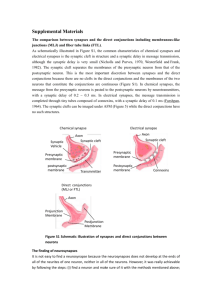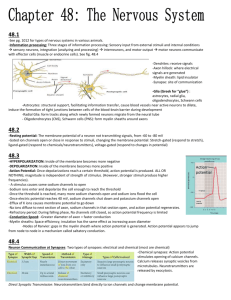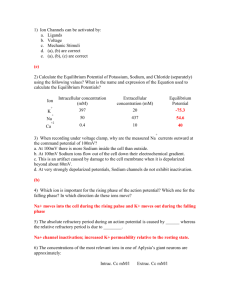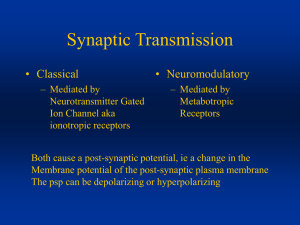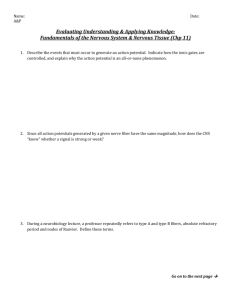SUPPLEMENTARY MATERIAL
advertisement
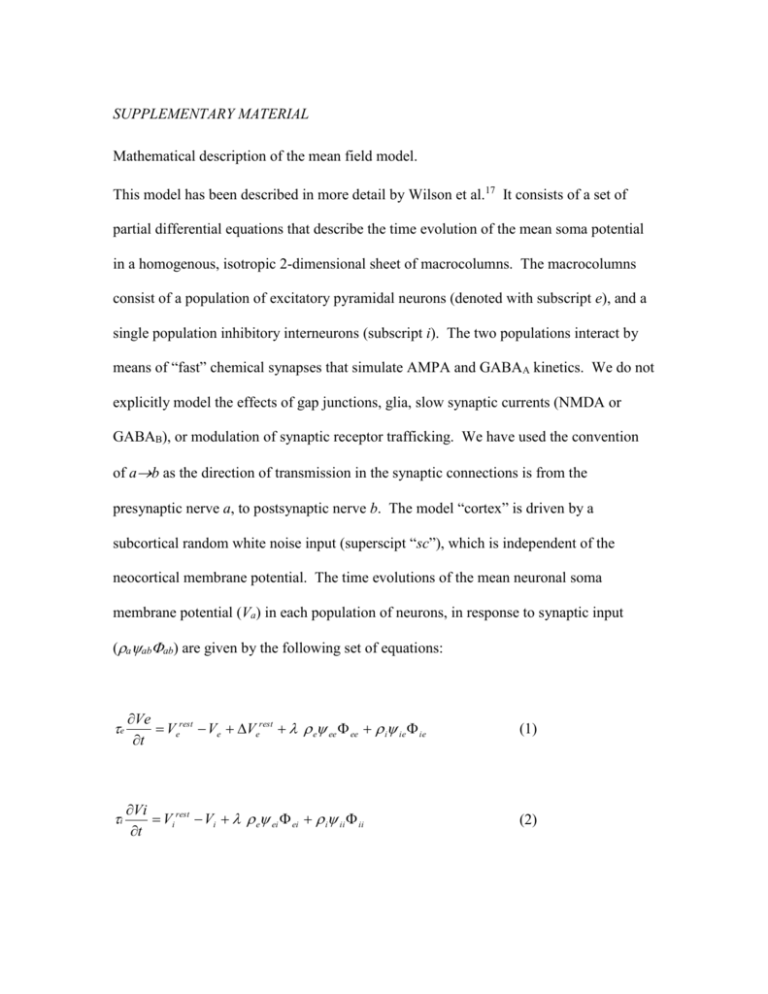
SUPPLEMENTARY MATERIAL Mathematical description of the mean field model. This model has been described in more detail by Wilson et al.17 It consists of a set of partial differential equations that describe the time evolution of the mean soma potential in a homogenous, isotropic 2-dimensional sheet of macrocolumns. The macrocolumns consist of a population of excitatory pyramidal neurons (denoted with subscript e), and a single population inhibitory interneurons (subscript i). The two populations interact by means of “fast” chemical synapses that simulate AMPA and GABAA kinetics. We do not explicitly model the effects of gap junctions, glia, slow synaptic currents (NMDA or GABAB), or modulation of synaptic receptor trafficking. We have used the convention of ab as the direction of transmission in the synaptic connections is from the presynaptic nerve a, to postsynaptic nerve b. The model “cortex” is driven by a subcortical random white noise input (superscipt “sc”), which is independent of the neocortical membrane potential. The time evolutions of the mean neuronal soma membrane potential (Va) in each population of neurons, in response to synaptic input (aabab) are given by the following set of equations: e Ve Verest Ve Verest e ee ee i ie ie t (1) i Vi Vi rest Vi e ei ei i ii ii t (2) where a are the neuron soma time constants, a are the strength of the post synaptic potentials (they are multipliers of the total area under the postsynaptic potentials), ab are the weighting functions that allow for the effects of reversal potentials and are described by the equation: ab Varev Vb rev Va Varest (3) and ab are the synaptic input spike-rate densities which are described by the following equations (4 to 7). These are a set of second-order ordinary differential equations which describe the postsynaptic (dendritic) impact of a delta-function spike of activity at the synapse. The shape of the postsynaptic potential is given by the solution (Green’s function) to the differential equation, and is a so-called “alpha-function.” 2 2 2 ee ee2 ee ee2 N ee ee N ee Qe eesc t t 2 2 2 ei ei2 ei ei2 N ei ei N ei Qe eisc t t 2 2 2 ie ie2 ie ie2 N ie Qi iesc t t 2 2 2 ii ii2 ii ii2 N ii Qi iisc t t (4) (5) (6) (7) where ab are the synaptic rate constants, N are the number of long-range connections between macrocolumns, and N the number of local intra-macrocolumn connections. It should be noted that these equations are describing the average impact of the excitatory and inhibitory dendritic input onto the soma of the neuron; and thus would include dendritic modulation and summation of pure synaptic input. The mean axonal velocity is given by, and the characteristic length (the length at which the connectivity between neuronal populations decays to 1/e) is 1/ea. These spatial interactions amongst the macrocolumns are described by the two equations (8 and 9): 2 2 2 ee 2 2ee 2 2 ee 2 2ee Qe t t (8) 2 2 2 ei 2 2ei 2 2 ei 2 2ei Qe t t (9) The relationship between the mean neuronal population firing-rate and the mean soma potential is given by sigmoidal functions (equations 10 and 11). An alternative interpretation, is the probability of a neuron firing at a particular membrane potential. Qe (Ve ) Qi (Vi ) Qemax 1 exp (Ve e ) 3 e Qimax 1 exp (Vi i ) 3 i (10) (11) where a describes the inflexion point membrane potential, and a the standard deviation of the threshold potential. This parameter is a composite indicator of both: (i) the degree of homogeneity within the population of neurons, and (ii) whether the neurons show “bursting” vs “regular-spiking” responses to injected current. The parameters and ranges used in our simulations are shown below. The parameters values are a composite, derived from numerous different published papers in which the real neurophysiological values for individual neurons have been measured. The parameters are not freely adjusted post-hoc to fit the observed dynamics or the EEG spectra. Real nervous systems seem to tolerate quite a lot of variation in parameter values. In this model, variation in most of our parameters had little effect on the qualitative output. There were two exceptions. 1) The mean resting membrane potential; where small alterations had large dynamic effects. This is in agreement with the large literature showing the importance of intrinsic ion-channel control of neuronal excitability. 2) The slope of the sigmoid membrane-potential-firing-rate relationship. This is more difficult to measure experimentally, and remains an important open issue in our model. Table. Parameters for model rat cortex Symbol Description Value e,i Membrane time constant 15, 15 ms Qe,i Maximum firing rates 30, 60 s1 e,i Sigmoid Thresholds e,i Standard deviation of thresholds e,i Gain per synapse at resting voltage Vreve,i Synaptic reversal potential Vreste,i Synaptic resting potential Nea Long-range e to e or i connectivity 58, 58 mV 3, 5 mV 0.001, 0.001 mVs 0, 70 mV 64, 64 mV 1500 Nea Short-range e to e or i connectivity 1000 Nia Short-range i to e or i connectivity 550, 850 scea Mean e to e or i subcortical input ea Baseline excitatory synaptic rate constant 300 s1 ia Baseline inhibitory synaptic rate constant 80 s1 Lx,y Spatial length of cortex amac Area of macrocolumn 0.5 mm2 ea Inverse length connection scale 14 cm1 v Mean axonal conduction speed 140 cm s1 50 s1 2 cm The model was implemented using Matlab (Mathworks, Natick, MA, USA), in a simulation of 4cm2 cortex with toroidal boundary conditions. This is approximately the area of the rat cortex. The simulations were done using the Euler method and a 0.1ms time step for integration, and spatial discretization of 0.1mm. To model the effects of the volatile general anesthetic agents, the IPSP time course was altered by changing ia, and the total area of the IPSP by increasing i. The area under the EPSP was altered by modulating e, and extrinsic input altered by changing sce. Previous studies have modeled the effect of sleep on intrinsic ion channels as changes in Vreste,i. Closure of potassium currents – such as by M1 acetylcholine receptors – would depolarize the resting membrane potential; and opening the channels – such as by adenosine during sleep – would hyperpolarize the resting membrane potential. From Banks and Pearce’s data we can construct the following table to guide the effect of volatile general drugs on the IPSP parameters. ISOFLURANE ENFLURANE IPSP DECAY TIME CONST 1MAC 2.5 3.6 2MAC 3.9 4.0 IPSP AREA 1MAC 2.2 2.2 2MAC 3.6 1.8 PEAK AMPLITUDE 1MAC 1 0.6 2MAC 0.85 0.5 As described in the main body of the paper, we modeled the effect of 1.5-2MAC enflurane on the IPSP as increasing the standardized IPSP area from 1.0 to 1.8, and slowing the decay time constant from 11.1ms to 33ms. We chose 11ms rather than the 20ms (from the Banks and Pearce paper) for the value of the baseline decay time constant, because other papers have observed much shorter time constants in the neocortex, than the hippocampus. The value of the IPSP time constant for 1.5-2MAC enflurane is somewhat of an underestimate, but further prolongation of the IPSP magnifies the effects; and produces a very similar EEG pattern as shown in Supplementary Figure 1 (see Supplementary Digital Content 3, http://links.lww.com/AA/A20.) Stability analysis, similar to Figure 7 in the paper – but using a longer decay time constant (I = 80msec), showing the effect of differing values of total area under the IPSP curve (lambdai). 2MAC enflurane is modelled as lambdai = 1.8, and 2MAC isoflurane as lambdai = 3.5. This shows the protective effect of having a large total IPSP area (or alternatively a preserved IPSP peak amplitude).




